
About UsThe Numismatic Bibliomania Society is a non-profit organization promoting numismatic literature. For more information please see our web site at coinbooks.org SubscriptionsThose wishing to become new E-Sylum subscribers (or wishing to Unsubscribe) can go to the following web page link MembershipThere is a membership application available on the web site Membership Application To join, print the application and return it with your check to the address printed on the application. Membership is only $15 to addresses in the U.S., $20 for First Class mail, and $25 elsewhere. For those without web access, write to: David M. Sundman, Secretary/TreasurerNumismatic Bibliomania
Society AsylumFor Asylum mailing address changes and other membership questions, contact David at this email address: dsundman@LittletonCoin.com SubmissionsTo submit items for publication in The E-Sylum, just Reply to this message, or write to the Editor at this address: whomren@coinlibrary.com
BUY THE BOOK BEFORE THE COINYou won't regret it! |
- WAYNE'S WORDS: THE E-SYLUM APRIL 12, 2009
- NUMISMATIC LITERATURE DEALER JOHN BURNS' SPRING COIN SHOW SCHEDULE
- FANNING JUNE 4, 2009 AUCTION LOT IMAGES AVAILABLE
- JOURNAL OF ANCIENT NUMISMATICS NO. 3 PUBLISHED
- QUEEN DISTRIBUTES COINS IN TRADITIONAL MAUNDY THURSDAY CEREMONY
- JAPANESE AND CHINESE MEDALS WITH SEAL SCRIPT
- MORE ON COINS AND MEDALS DEPICTING SOLAR ECLIPSES
- MORE ON THE SIDNEY OHIO '45365' MOVIE
- AN UNUSUAL LOVE TOKEN FIND
- QUERY: WHERE ARE ADMIRAL NIMITZ'S AUTOGRAPHED HAWAII NOTES?
- GERMAN TRANSLATORS SOUGHT FOR KARL GOETZ ARCHIVE PROJECT
- ECKFELDT FARM LOCATION CONFIRMED
- NEW INFORMATION ON J. L. POLHEMUS COUNTERSTAMPS
- THE DIGITAL DILEMMA
- HOW TO SAVE PERMANENT COPIES OF EPHEMERAL WEB PAGES
- NEOCOLLECT.COM INCORPORATES E-SYLUM FEEDBACK
- ARE TELLERS WHO BUY VALUABLE DEPOSITED COINS GUILTY OF THEFT?
- MORE ON THE HORSE NAMED NUMISMATIST
- FIRM ESTIMATES TWICE AS MANY CIRCULATING COUNTERFEIT ONE POUND COINS
- DETECTING COUNTERFEIT COINS BY THEIR SOUND
- SOURCE OF "AMERO NOTES" UNCOVERED
- SO WHY IS PRESIDENT JOHN ADAMS DEPICTED ON AN ALASKA STATEHOOD MEDAL?
- USA TODAY ARTICLE ON ALTERNATE CURRENCIES
- ESTONIA'S BANK OF HAPPINESS ALTERNATIVE CURRENCY
- MORE ON AUSTRIAN NOTGELD REFERENCES
- ARTICLE AND WEB SITE HIGHLIGHT 1888 RUGBY MEDAL
- BANKNOTES OF THE WORLD DECORATE PEG LEG PETE'S OF PENSACOLA
- NEW BERMUDA BANKNOTES ARE TURNING HEADS
- FEATURED WEB SITE: REBEL STATES CURRENCY
WAYNE'S WORDS: THE E-SYLUM APRIL 12, 2009
 Among our recent subscribers are Megan Fenselau of the American Numismatic Society, Chris Salmon, Jeff Swindling, Greg Meyer, and Mark Verbeck. Welcome aboard! We now have 1,229 subscribers.
Among our recent subscribers are Megan Fenselau of the American Numismatic Society, Chris Salmon, Jeff Swindling, Greg Meyer, and Mark Verbeck. Welcome aboard! We now have 1,229 subscribers. Sorry about last week's delay; I don't think an issue has ever been that late. On Monday I got past the initial password problem I had Sunday night, and that night I was able to complete proofreading the issue and adding a few items that had arrived over the weekend and not made the cut.
Come midnight I discovered a second problem - our provider wasn't forwarding emails as normal and once again, I couldn't scare up their technical support at midnight. You can't get good help these days. Thank you for your patience.
David Fanning wrote:
Ken Bressett wrote:
Joel Orosz wrote:
This week we open with updates from two numismatic literature dealers and a report on the 2009 Maundy Money ceremony. Topics include seal script, coins and medals depicting solar eclipses, new information on J.L. Polhemus, and detecting counterfeit coins by sound. New queries include help for translating an archive of Karl Goetz material and learning why John Adams is depicted on a medal for Alaska statehood.
In addition, we have multiple items this week on alternate currencies and circulating counterfeit coins. To learn about the horse named Numismatist and join in the search for Admiral Nimitz' autographed Hawaii notes, read on. Have a great week, everyone!
Wayne Homren
Numismatic Bibliomania Society
NUMISMATIC LITERATURE DEALER JOHN BURNS' SPRING COIN SHOW SCHEDULE
Itinerant numismatic literature dealer John H. Burns and his travelling book shop will be attending the following shows:- Cincinnati EAC April 16-19
- Chicago International April 23- 26
- Cincinnati CSNS April 30-May 2
FANNING JUNE 4, 2009 AUCTION LOT IMAGES AVAILABLE

To find the Facebook site, just go to www.facebook.com and search for David F. Fanning Numismatic Literature. Thanks!
JOURNAL OF ANCIENT NUMISMATICS NO. 3 PUBLISHED
Earlier in The E-Sylum we noted the great work being done by Alfredo De La Fe of Imperial Coins & Artifacts, Inc. in publishing his new online newsletter on ancient numismatics. The third issue has just been published, and with it comes an appropriate name change. It is now The Journal of Ancient Numismatics.
Articles in this issue are:
- A Greek Coin Refresher Course By: David L. Vagi
- Lucullus, A Second Best Hero of the Roman Republic By: Marvin Tameanko
- Dating Some Republican Mini-Issues By: Mark Passehl
- What Makes a Collection Important? By: Wayne G. Sayles
- A Double-Portrait Elagabalus and Julia Paula From Perinthus By: Curtis L. Clay
- The Amphora Was Used For Temple Wine Libation By: David Hendin
- Numismatic Collaboration in Some Former Soviet Bloc Nations By: Georges Depeyrot
- MEDIA REVIEW - Three Excellent Ancient Numismatic Websites By: Alfredo De La Fe
- Ancients in the news - Articles of interest to Ancient Numismatists By: Alfredo De La Fe (Editor)
To read the complete issue, see: Volume 3 , Issue 1 (imperialcoins.com/newsletters/volume3/)
THE BOOK BAZARRE
QUEEN DISTRIBUTES COINS IN TRADITIONAL MAUNDY THURSDAY CEREMONY
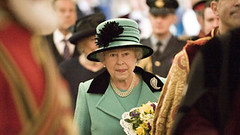 A 107-year-old woman was among those who received specially-minted "Maundy Money" coins at an age-old Easter ceremony in Bury St Edmunds, Suffolk. Kathleen Grimwood, of Sudbury, may have been the oldest recipient in history when given the money at St Edmundsbury Cathedral, Buckingham Palace said.
A 107-year-old woman was among those who received specially-minted "Maundy Money" coins at an age-old Easter ceremony in Bury St Edmunds, Suffolk. Kathleen Grimwood, of Sudbury, may have been the oldest recipient in history when given the money at St Edmundsbury Cathedral, Buckingham Palace said. On Maundy Thursday each year the monarch gives coins to subjects in a tradition dating to the 13th Century. The Queen now gives the money to people nominated for service to the community.
She gave coins to 83 women and 83 men during a service at the cathedral in Bury St Edmunds - one male and one female recipient for each year of her life.
Each pensioner received a red purse containing a £5 coin celebrating the 500th anniversary of the accession of Henry VIII, and a 50p coin to celebrate the founding of Kew Gardens. They were also given a white purse containing 83p in Maundy coins. All the coins have been minted in 2009.

The Queen and the Duke of Edinburgh chatted to locals during a walkabout following the service. Thousands turned out to watch the monarch arrive amid tight security as large parts of the town centre were closed off.
To read the complete article (and view a video of the ceremony), see: Maundy Money handed out by Queen (news.bbc.co.uk/2/hi/uk_news/england/suffolk/7991228.stm)
JAPANESE AND CHINESE MEDALS WITH SEAL SCRIPT
Joe Boling writes:
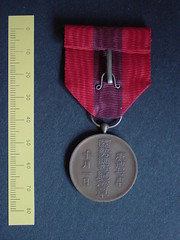
Joe kindly provided images. He adds:
Similarly, the second and fourth characters in the left columns are the same - and you can see more similarity, but it's still obvious that the calligrapher took great liberties with the seal script characters. They can be a real bear to read (and can be even more elaborate and far from "normal").
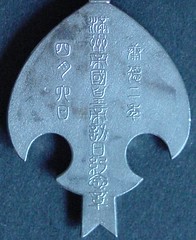
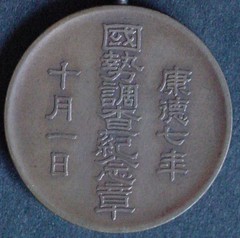
MORE ON COINS AND MEDALS DEPICTING SOLAR ECLIPSES
Regarding coins or medals commemorating solar eclipses, Eric Holcomb of Bend, OR writes:I’m sure there must be other eclipse-related numismatic items (including other coins listed in the standard catalog); if I come across any others (including for this year’s event), I’ll let you know. Surely the Chinese mints and eBay sellers won’t miss such an opportunity! There are still a few cabins available on my cruise out of Tianjin, China (near Beijing) this July … see http://www.astronomyvacations.com/ for more info.
Another E-Sylum reader writes:
"Eclipses have been depicted on coins since ancient times, reports Michael Marotta in the December 2005 issue of Numismatist. A partial listing of numismatic items depicting eclipses is available at the Web site eclipse-chasers.com/tseCoins.html ".
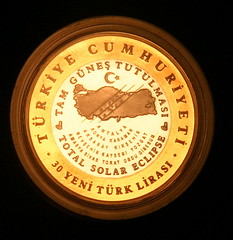
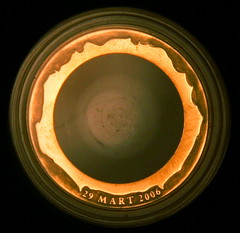
MORE ON THE SIDNEY OHIO '45365' MOVIE
Regarding the new film about the home of Coin World (Sidney, OH), an E-Sylum reader writes: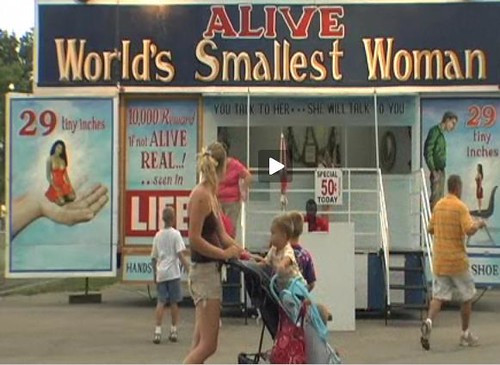
The trailer has a number of beautiful farm country scenes and local color, including marching bands, football games and a fair. To view the trailer, see: 45365 (www.imdb.com/video/wab/vi2853831449/)
Regarding the 1960 documentary on Sidney, Dick adds:
AN UNUSUAL LOVE TOKEN FIND
Greg Anglin writes:As I was walking to the trash can with it I noticed it had some type of friction mechanism inside the cab. I actuated the mechanism & out popped what I thought was a round game piece or slug, but then I noticed it looked like a coin. I recognized it because I happen to be a coin collector.
I got out my loupe and looked at it closely. It turns out it was an 1854 Seated Liberty quarter! On the date side it had traces of old mountings and the other side had been planed down and made into a love token with the initial "J" with a fancy scroll on either side. This probably has very minimal value but what an unusual way to find an old coin or love token!
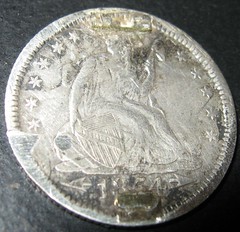
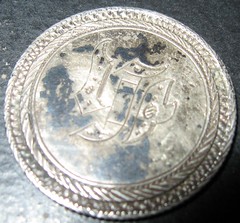
QUERY: WHERE ARE ADMIRAL NIMITZ'S AUTOGRAPHED HAWAII NOTES?
 Green was the Executive Officer to the Military Governor of Hawaii. Prior to the declaration of martial law, then Lt. Col. Green was the Chief Judge Advocate in for the Army's Hawaii Department. As the Army's top lawyer in Hawaii, he was largely responsible for the implementation of martial law on the islands. General Green wrote a personal account of the Military Government of Hawaii which includes an entire chapter on money and banking on the islands. This chapter covers the issuing of the Hawaii overprint notes (which the General takes personal credit for creating.) In another part of the book, he details what happened to a select few of the Hawaii notes. The following is an excerpt from the book. The bracketed information are my comments.
Green was the Executive Officer to the Military Governor of Hawaii. Prior to the declaration of martial law, then Lt. Col. Green was the Chief Judge Advocate in for the Army's Hawaii Department. As the Army's top lawyer in Hawaii, he was largely responsible for the implementation of martial law on the islands. General Green wrote a personal account of the Military Government of Hawaii which includes an entire chapter on money and banking on the islands. This chapter covers the issuing of the Hawaii overprint notes (which the General takes personal credit for creating.) In another part of the book, he details what happened to a select few of the Hawaii notes. The following is an excerpt from the book. The bracketed information are my comments.[General Emmons was the Commander of the Hawaii Department as of December 17, 1941 having replaced General Short. General Emmons was the first Military Governor of Hawaii. The Hawaii overprint notes were first issued during General Emmons tenure as Military Governor.]
The only distinguishing marks were overprints indicating that it was currency to be used in Hawaii. I obtained the first four one dollar bills of the Emmons money to be issued in Hawaii by exchanging for it four one dollar bills of regular currency. At my request, General Emmons endorsed his name on all four bills and I did likewise. I then sent all four bills to Admiral Nimitz with the request that he endorse his name on all four bills, retain one for his scrapbook and return the other three to me.
With his reply, dated July 29, 1942, Admiral Nimitz returned all four of the bills, duly endorsed, and stating that he was not including American currency in his scrapbook...
[Your homework, dear readers, is to find these four notes and obtain images of them. General Green's papers are at the Army's Judge Advocate Generals Legal Center and School Library in Charlottesville, VA. The Adjutant General note may be at the Adjutant General Museum at Fort Jackson, SC. If not, the curator should know where to look.
I could find no information on the papers of General Emmons. There is no indication what General Green did with the note intended for Admiral Nimitz. It may still be in his papers in Virginia. For the record, the papers of Admiral Nimitz are at the Operational Archives Branch of the Naval Historical Center at the Washington Navy Yard.]
GERMAN TRANSLATORS SOUGHT FOR KARL GOETZ ARCHIVE PROJECT
We are seeking people proficient in German to help transcribe and translate these documents relating to the life and career of Karl Goetz. Many are manuscripts and most printed matter is in the old style German script, so being able to read those is necessary. Those with an advanced technical vocabulary and/or knowledge of early 20th century German society and institutions will be of invaluable assistance. Whatever your skills, if you think you may have time to help translate, or simply just proofread others’ work, please do drop us a line and let us know how you can help. Just click the ‘Contact’ link at the web site below, fill in the necessary information, and send it off to us. We’ll get right back to you with site access information.
If you do not know the German language you are still invited to view the work as it progresses. You might be surprised by the ephemera images from Karl Goetz and his life.
http://goetz.numispedia.org
ECKFELDT FARM LOCATION CONFIRMED
Information vital to numismatic research is frequently found in publications that would be considered non-numismatic. An example is Haverford Township compiled by the Haverford Township Historical Society and published by Arcadia Publishing in 2003.
On page 98 is a photo of a house. The caption says
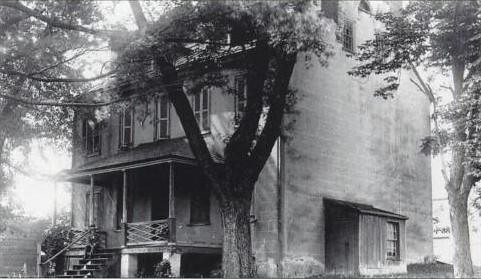
The Lower Merion Historical Society has a website with links to historical maps of the area. An atlas for 1881 shows a 92 acre farm for the Jacob Eckfeldt Estate located west of City Line Avenue and Earlington Road. The 1900 atlas gives the same location. This would indicate that the farm remained with the family from 1794 to at least 1900.
The Haverford Township book says, “The earliest photographs contained in this book were taken by Dr. John W. Eckfeldt. A prominent physician in Philadelphia, Eckfeldt developed a passion for nature during his summer visits on his grandfather’s farm, located on the land now known as Chatham Park and Llanerch.”
Llanerch (A Welsh name) appears on atlases just west of the Eckfeldt property. I am not sure what is considered Chatham Park.
That’s the new information. Does it fit together?
Adam Eckfeldt (1769-1852) was about 25 years old in 1794 and starting his job at the Mint. Adam died in 1852 and Jacob Reese Eckfeldt (1803-1872) was his oldest surviving son. It is likely that Jacob inherited the farm although he continued to work as assayer at the Mint. Jacob died in 1872.
If Adam had a house in town and another in the country at age 25, this suggests that he had assets beyond what he made as a blacksmith. (He also owned a company that made nails.) Although he may have associated with other tradesmen, he was included in the social circle with Philadelphia professionals.
Adam Penn Eckfeldt (1837-1895) was the oldest son of Jacob Reese Eckfeldt and likely heir. In the 1880 census he is listed as a retired farmer living with his mother. Although he may have worked his father’s farm, he apparently did not inherit it.
Adam Columbus Eckfeldt (1812-1890) was a farmer in Haverford Township from 1838 to 1865 and younger brother of Jacob. He may have worked the farm while his brother worked as assayer.
Joseph Cloud (1770-1845) died in 1845 and his farm at Radnor passed to someone named Adam Eckfeldt. I believe it is more likely this was the Adam who was one year older and co-worker at the Mint rather than Adam Columbus Eckfeldt who was 42 years younger. I also believe this property was unrelated to the farm managed by the Eckfeldt family for generations.
This has little importance in numismatics. It will only be important to an obsessed researcher interested in biographical research. I guess that applies to me.
NEW INFORMATION ON J. L. POLHEMUS COUNTERSTAMPS
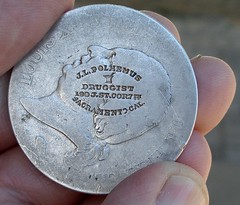
Since then the coin has greatly depreciated, and it is said that a cunning financier in Sacramento, is, and has been, engaged for some time in collecting all francs and forty-cent pieces containing the Polhemus stamp, intending to make him redeem them at the rate they were current at when he put his endorsement upon them; and having taken legal advice upon the question, he is confident of calling the druggist to refund. It is said that at least one hundred dollars will be made by the speculation.
To read the previous E-Sylum items, see: QUERY: METAL DETECTORIST FINDS J.L POLHEMUS COUNTERSTAMP ON FRENCH COIN (www.coinbooks.org/esylum_v11n34a09.html)
PHOTOS: J.L POLHEMUS COUNTERSTAMP ON FRENCH COIN (www.coinbooks.org/esylum_v11n35a13.html)
THE DIGITAL DILEMMA
The book on the shelf requires no page riffling to keep it readable. Hard Drives are designed to be “powered on and spinning”. They cannot just be stored on a shelf for long periods of time. They need to be played occasionally to keep their lubrication across the data-recording surface.
The current state of the art for digital archiving requires migration every five to seven years and constant file/hard disc maintenance in the interim. Migration involves the transfer of data from old physical media to new physical media, a process that often includes updating file formats for currency with the latest generation operating system and/or software applications. Books and 35mm film can usually be stored and ignored for 50 to 100 years with little harm.
I am truly amazed how often E-sylum readers are dealing with texts from the 16th to the 19th century. Imagine the difficulty the 24th century numismatist would face trying to access Mr. Levy’s Mughal and Durrani coins on a 21st century NeoCollect. Here is an access story bibliophiles might relate to:
The BBC Domesday Project was a pair of interactive videodiscs made by the BBC in London to celebrate the 900th anniversary of the original Domesday Book. It was one of the major interactive projects of its time, involving the work of 60 BBC Staff, a budget of two million pounds and the volunteer efforts of thousands of British schoolchildren and teachers.
The modern Domesday contained text, photographs, video, maps and data and a controlling computer program to bind it all together. The final package was published on two custom-designed laser disks with the special controlling software designed for the BBC Micro, a popular microcomputer. This software program was composed of 70,000 lines of custom code written in BCPL, a forerunner of the widely used C programming language.
Within 15 years, it was impossible to use the “digital” Domesday, as compared to the original Domesday Book, which was handwritten, probably by a single monk in 1086 and which is still readable (in Latin) if one goes to the UK National Archives, where it has been preserved.
However, in 2002, a research project by the University of Leeds and the University of Michigan managed to successfully emulate the original BBC system using modern hardware and software, one of the pioneering efforts in digital “archeology” that enabled continuing access to old, nearly “extinct” digital media assets.
Other than personal opinions, most of the material cited above came from: The Digital Dilemma, Strategic Issues in Archiving and Accessing Digital Motional Picture Materials; Milt Shefter and Andy Maltz, the Science and Technology Council, Academy of Motion Picture Arts and Sciences, Academy Imprints, Beverly Hills, CA 2007. This is a study that really asks more questions than gives answers.
The fascinating thing about the study is that it examines not only the struggles of the motion picture industry but also the federal government, the Library of Congress, Oil Exploration Companies, National Archives and Records Administration, the Dept. of Defense, the Medical Profession and HIPPA, The Center for Earth Resources Observation and Science, and the National Satellite Land Remote Sensing Data Archive.
What I got out of all this is if I write a book, and I want to be sure future generations can read it, I better publish some hard copies and give them to libraries whose mission is the preservation of numismatic material.
HOW TO SAVE PERMANENT COPIES OF EPHEMERAL WEB PAGES
Next I clicked on the link up came the page. I right clicked on my Vista PC and selected convert to Acrobat PDF. My program of Adobe Acrobat 7, converted the pages. At the end, I saw a link to Page 2, which I clicked on. My program continued to convert them to PDF. I had saved the first file to Documents/Temp/NeoCollect - Mughal Coins.pdf. When I finished the second file I again saved it.
Viewing the 14 pages in PDF, in the saved file on my hard drive - they seem to be fine. If I were David, this procedure could be followed with all of his collection files on NeoCollect, since he is the copyright owner of the data (except the ads, etc. for which he may need to get permission.
Then as a final step to retaining the information and photos on paper, he could upload the files to www.lulu.com and print one copy of the book (his collection) for a reasonable fee.
You can see the similarity to the many, many years of work I did on my own collection, burning a CD, posting it free on the Internet (now removed) printing the book thru Lulu, and then giving it to Google books with the hope they will keep it up for a long time, plus I have it on paper.
NEOCOLLECT.COM INCORPORATES E-SYLUM FEEDBACK
The second suggestion was to provide users a way to export their data into an Excel spreadsheet as a backup, in case of either a technical glitch or the disappearance of the site entirely. We’ve gone ahead and added this function as well! Even before, NeoCollect enabled users to generate custom reports including any or all of their collection data, for example for an insurance report or to help out a researcher. And any of these reports can be downloaded into Excel. In order to make the site easier to use, though, we have added the comprehensive Excel download option directly to both the My Reports section and to the user’s My Collections pages, to make things more simple and quick. These spreadsheets and reports can also be printed in Adobe pdf format.
This download option is more an opportunity than a need, since we back up all NeoCollect data daily. We’re also not going anywhere that you won’t be able to find us. I enjoy using the site tremendously for my own collection and have only just begun. While all of my Betts medals are listed, I’ve listed only about 10% of my school medal collection so far and haven’t even begun with my various collections of Americana. So keep checking NeoCollect, and try using it yourself if you haven’t already.
www.NeoCollect.com
ARE TELLERS WHO BUY VALUABLE DEPOSITED COINS GUILTY OF THEFT?
Before moving to California to assume my present position, I was fortunate to have the opportunity to be in close contact with several local branches of larger financial institutions and was able to give presentations to groups of tellers explaining that they were not acting in the best interest of their patrons by taking as deposit or cashing (as in this case) their old coins.
Several tellers were ignorant to the fact that they were "stealing" when they "bought" the money from the bank at face and went to the local coin dealer to sell the coins as theirs.
Following my programs I was able to assist in several instances of mostly elderly patrons who did not know the value of their money; to obtain outside assistance, to grow their initial few dollars of deposit to more and thus having a larger deposit for their accounts.
To read the earlier E-Sylum article, see: "GROCERY MONEY" WOMAN ARRESTED FOR STEALING GOLD COINS (www.coinbooks.org/esylum_v12n14a26.html)
MORE ON THE HORSE NAMED NUMISMATIST
Web site visitors Mike and Mary Kindred write:We were told by an Englishwoman friend that every gentleman should have a collection. This, coupled with name Near Mint (an obvious reference to quality), inspired the name Numismatist.
Though we hold gold coins for investment purposes, neither of us would be classified as numismatists. The subtle play on words here is that we want the horse to collect all the coins he possibly can. So far, he has won four races, and collected over $141,000. He will run at Arlington Park in Chicago from May 1 through the end of September.
To read the earlier E-Sylum item, see: A HORSE NAMED NUMISMATIST (www.coinbooks.org/esylum_v11n49a25.html)
FIRM ESTIMATES TWICE AS MANY CIRCULATING COUNTERFEIT ONE POUND COINS
Official figures suggest around 2.5% - or one in 40 - are copies, but coin testing companies say it is one in 20.
Andy Brown of Willings, a firm which makes machines to check coins for other businesses and organisations, says there could be 73 million fake coins.
He said: "We would estimate that as many as 5% of coins we test are fakes.
"We've been collating them for the past four months or so, and already have a collection of several hundred."
The figures quoted by the Royal Mint were wide of the mark, he added.
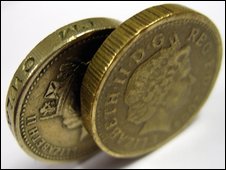
A fake pound coin (right) alongside the real thing
Former Queen's Assay Master Robert Matthews - a leading authority on fake coins - is also worried.
He said: "The Mint is really trying to play down the problem and keep it as low-key as possible.
"They've not produced any publicity material for banks etc to tell us how to differentiate between real and fake coins.
"They don't want to undermine public confidence in the coins, you might get people refusing to take them."
Mr Brown believes the Royal Mint's official figures on the number of fake coins will continue to rise.
"Their percentage will go up as they get better at detecting fakes," he said.
To read the complete article, see: Fake £1 coin estimate 'doubled' (news.bbc.co.uk/2/hi/uk_news/7988001.stm)
DETECTING COUNTERFEIT COINS BY THEIR SOUND
Suzuki's method sounds relatively simple, no pun intended. Slide a coin down a brass-plated chute. A computer analyzes the sound the coin makes as it slides, determining if the coin is genuine or not from the noise the coin generates. This relatively quick method is increasingly replacing labor intensive methods the Japanese police had to use, either using a microscope or subjecting coins to fluorescent X-rays, which could take up to three to five minutes per coin.
There is already talk about applying this technology to vending machines, where according to the Feb. 26 Daily Yomiuri or Yomiuri Shimbun newspaper in Japan, a 30 millimeter brass composition chute allowing for oscillation provided by an accompanying high-performance microphone would allow computer analysis of each coin vended.
Suzuki told the Japanese newspaper he is aware of different frequencies between each coin denomination and of the difference in frequencies between genuine and fake coins. He was particularly focused on the hardness and density of each coin.
Suzuki is quoted in the newspaper article as saying, "I hit upon the idea of making the device from my image of a coin clinking when it is put into a piggy bank."
To read the complete article, see: Sound Determines if Coins are Sound (www.numismaster.com/ta/numis/Article.jsp?ad=article&ArticleId=6543)
THE BOOK BAZARRE
SOURCE OF "AMERO NOTES" UNCOVERED
This week one of our favorite web sites, the Internet hoax-debunking site Snopes.com located the true origin of the images. -Editor
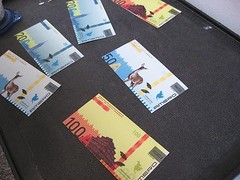
As a picture of the back of one of these Amero notes clearly shows, the bill was an element of a project intended to "prompt discussion about questions related to the monetary interdependence in North America" and was most assuredly not, as Turned asserted, an official specimen of "a new currency already being printed and quietly distributed around the world."
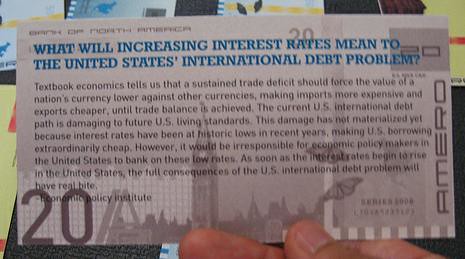
To read the complete article, see: Amero Notes (www.snopes.com/politics/business/ameronote.asp)
SO WHY IS PRESIDENT JOHN ADAMS DEPICTED ON AN ALASKA STATEHOOD MEDAL?
Dick Hanscom of Alaska Rare Coins writes:It was made by Medallic Arts Co. (MACO). It has President John Adams on the obverse, and the Alaska state seal on the reverse. I have never figured out the connection. Why would an Adams presidential medal have the Alaska state seal on the reverse, or vice versa?
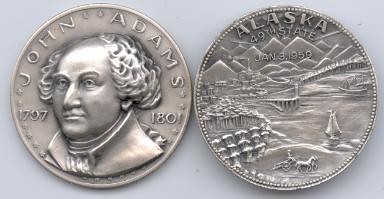
USA TODAY ARTICLE ON ALTERNATE CURRENCIES
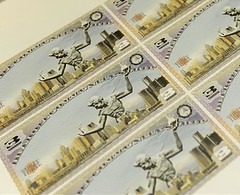 A small but growing number of cash-strapped communities are printing their own money. Borrowing from a Depression-era idea, they are aiming to help consumers make ends meet and support struggling local businesses.
A small but growing number of cash-strapped communities are printing their own money. Borrowing from a Depression-era idea, they are aiming to help consumers make ends meet and support struggling local businesses.The systems generally work like this: Businesses and individuals form a network to print currency. Shoppers buy it at a discount — say, 95 cents for $1 value — and spend the full value at stores that accept the currency.
Workers with dwindling wages are paying for groceries, yoga classes and fuel with Detroit Cheers, Ithaca Hours in New York, Plenty in North Carolina or BerkShares in Massachusetts.
Ed Collom, a University of Southern Maine sociologist who has studied local currencies, says they encourage people to buy locally. Merchants, hurting because customers have cut back on spending, benefit as consumers spend the local cash.
During the Depression, local governments, businesses and individuals issued currency, known as scrip, to keep commerce flowing when bank closings led to a cash shortage.
By law, local money may not resemble federal bills or be promoted as legal tender of the United States, says Claudia Dickens of the Bureau of Engraving and Printing.
"We print the real thing," she says.
Pittsboro, N.C., is reviving the Plenty, a defunct local currency created in 2002. It is being printed in denominations of $1, $5, $20 and $50. A local bank will exchange $9 for $10 worth of Plenty.
"We're a wiped-out small town in America," says Lyle Estill, president of Piedmont Biofuels, which accepts the Plenty. "This will strengthen the local economy. ... The nice thing about the Plenty is that it can't leave here."
To read the complete article, see: Communities print their own currency to keep cash flowing (www.usatoday.com/money/economy/2009-04-05-scrip_N.htm)
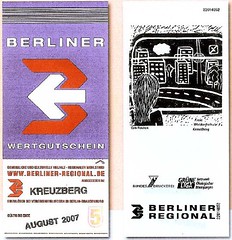 Howard adds:
Howard adds: Bill Rosenblum forwarded this related story about Berkshares on FoxNews: Communities Print Own Currencies to Keep Money Local (www.foxnews.com/story/0,2933,513877,00.html)
ESTONIA'S BANK OF HAPPINESS ALTERNATIVE CURRENCY
 On one level, it was just a haircut. Peeter, a middle-aged IT manager, entrusted his diminishing locks to Nele, a young craftswoman armed with goodwill and a pair of scissors. By all accounts, Peeter was delighted with his newly shorn pate. On another level, though, the clash of keratin against blades that took place in a Tallinn apartment last month was historic. For the cut was given free, with no exchange of cash or other payment, and is recorded as the first official transaction carried out by the Bank of Happiness in Estonia.
On one level, it was just a haircut. Peeter, a middle-aged IT manager, entrusted his diminishing locks to Nele, a young craftswoman armed with goodwill and a pair of scissors. By all accounts, Peeter was delighted with his newly shorn pate. On another level, though, the clash of keratin against blades that took place in a Tallinn apartment last month was historic. For the cut was given free, with no exchange of cash or other payment, and is recorded as the first official transaction carried out by the Bank of Happiness in Estonia. Unlike Eesti Pank (the Bank of Estonia) — a giant, gravel-coloured building that evokes the stern spirit of the Soviet Union — the Bank of Happiness has no carved wooden doors, imposing pillars or marble floors. Not a single Estonian kroon will sully its accounts, for it is a virtual bank that will trade purely on good deeds.
To become a client, an Estonian must register online, listing the useful things that he can do for others (eg, grocery shopping, walking a dog, fixing cars) and those that he would like done unto him (eg, having a suit darned or windows cleaned). The “bank” — really an internet portal to allow the civic-minded across Estonia to network altruistically with each other — will formally open for business in May. Professor Martin Seligman, a psychologist at the University of Pennsylvania, calls it “a creative idea, worth following closely”.
"We call it a bank because we want to bring forth a new set of values”, says Tiina Urm, a 26-year-old who helped to think up the idea and is the closest thing that the Bank of Happiness has to a manager. “At the moment we are glued to other people only through money. But that’s not how we evolved as a society. We used to work as a team.”
Money-free trading systems exist all over the world, including in the UK. Here they are known as local exchange trading systems (lets) and each has its own notional currency (in Milton Keynes it is the “concrete cow”, or CC). Members of MKLetNet pay £10 for mailings plus 20 CCs to get a directory listing what other people want and can offer, with contact details. The exact details of each transation are left to members but, once agreed, the deals are registered with a lets accountant.
The trouble with a money-free system is working out how different services compare. For example, how does a babysitter, who may charge £8 an hour, exchange services with a plumber, who may charge £40 an hour?
One solution is to value everyone’s time equally; this is the basis of time banks. One hour equals one time credit; the aim is to maintain a balance of zero, meaning that you have given as much time as you have received. An estimated 300 lets and time banks operate in Britain, numbering 100,000 people.
The time banking movement was set up Dr Edgar Cahn in America. Cahn’s view was that “the real work of society, which is caring, loving, being a citizen, a neighbour and a human being” was not addressed by market economics.
To read the complete article, see: Estonia's Bank of Happiness: trading good deeds (women.timesonline.co.uk/tol/life_and_style/
women/the_way_we_live/article6053885.ece)
MORE ON AUSTRIAN NOTGELD REFERENCES
Bob Knepper of Anaheim, CA writes: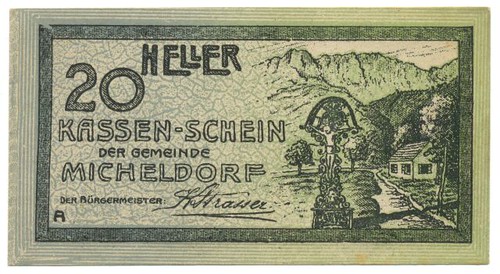
Anil Bohora writes:
Tony Tumonis writes:
Two excellent reference books on Austrian Notgeld Currency are Das osterreichische Notgeld 1917 bis 1922 and Das Osterreichische Notgeld Sonderserien 1919-122 both are written by Gottfried Meyerbeck.
The first lists and gives valuations for the regular issues, and the second lists and gives valuations for the Special Collector Issues. Written in German, both books are easy to follow.
ARTICLE AND WEB SITE HIGHLIGHT 1888 RUGBY MEDAL
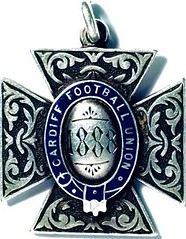 A rare medal to mark Penarth Rugby Club’s victory in the 1888 Cardiff Football Union Final is attracting bids of more than £70,000.
A rare medal to mark Penarth Rugby Club’s victory in the 1888 Cardiff Football Union Final is attracting bids of more than £70,000. The 121-year-old medal has been part of Cardiff businessman Dave Dalton’s collection for several years, after he discovered it in a house clearance.
But Mr Dalton was unaware of the medal’s significance - or of its value - until a collector dated it back to 1888.
Following the shock discovery, Mr Dalton set up a website to give rugby memorabilia collectors a chance to bid for the medal – and it has already attracted some huge offers.
“A number of other collectors have tried to help identify it – including collectors from New Zealand and Australia.
“But it wasn’t until I showed it to a local rugby historian in Cardiff that we realised what a rare object it was and how it fitted into the history of the very beginnings of Welsh rugby.”
Gwyn Prescott, who has researched the history of rugby in Cardiff in the 19th century, identified it as a medal marking the victory of Penarth in the 1888 Cardiff Football Union Cup final.
To read the complete article, see: Rugby medal causes a stir (www.penarthtimes.co.uk/news/latestnews/
4276348.Rugby_medal_causes_a_stir/)
See also: www.1888rugbymedal.co.uk
BANKNOTES OF THE WORLD DECORATE PEG LEG PETE'S OF PENSACOLA
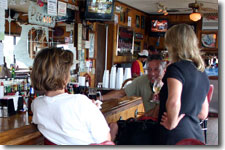 Flanked by rough-hewn walls covered with bank notes from around the world signed by tourists, Peg Leg Pete's bartender Karina Foster peers over her reading glasses and gripes good-naturedly about the crossword puzzle she's working on this slow Tuesday afternoon. She consults a patron about whether topaz is a Scorpio birthstone (it is), then serves a plate of the eatery's popular Oysters Rockefeller
Flanked by rough-hewn walls covered with bank notes from around the world signed by tourists, Peg Leg Pete's bartender Karina Foster peers over her reading glasses and gripes good-naturedly about the crossword puzzle she's working on this slow Tuesday afternoon. She consults a patron about whether topaz is a Scorpio birthstone (it is), then serves a plate of the eatery's popular Oysters RockefellerTo read the complete article, see: Bargains, beaches and Blue Angels beckon in Pensacola (http://www.usatoday.com/travel/destinations/affordableamerica
/2009-04-09-pensacola-deals_N.htm)
NEW BERMUDA BANKNOTES ARE TURNING HEADS
Where was this on April Fool's Day? And isn't anyone going to comment on the E-Sylum April Fools piece? I don’t know if it was too bad or too good, but no one has mentioned it. Anyway, be sure to read the whole original Bermuda piece - it's funny. -Editor
More than half the money in circulation now is the new colourful banknotes.
The new notes are so widespread now that several doctors have reported seeing patients with repetitive neck injuries from counting money with the new "sideways" printing.
The Chief Medical Officer issued a bulletin this week advising the general public, especially those like bank tellers and cashiers who handle large amounts of cash, to hold the money at right angles to the way old money was held.
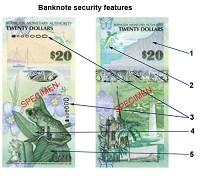
Many large retailers and banks have ordered money cash drawers and cash registers with the slots facing in a new direction, while new ATMs are being installed that dispense banknotes narrow-end first.
For those depositing money in ATMs, banks have ordered a new supply of envelopes that measure 10x5 inches, instead of the 5x10 inches formerly used. Traditional cheques will fit in the new envelopes if they are inserted end-first.
"The $10 note alone bears images of butterflies, turtles, leaping fish, angel fish, a parrot fish, and several other kinds of fish, a sea horse, a sea anemone, coral, the sun or moon rising over the horizon and puffy clouds, several maps of the island, the Commissioner's House, the Deliverance, a cannon, an anchor, some onions, several scuba divers and a picture of the Queen of England, not to mention a sailboat and hibiscus flower watermarks.
"If you can't find what you want here, you can look through the transparent oval in the middle of the banknote and see anything you happen to be facing.
To read the complete article, see: Our new 'sideways' currency is a real head turner (http://www.bermudasun.bm/main.asp?SectionID=4&SubSectionID=135&ArticleID=41085&TM=45620.27)
FEATURED WEB SITE: REBEL STATES CURRENCY
This week's Featured Web site is Kurt Jacoboni's Rebel States Currency - Currency Issued by the States of the Confederacy.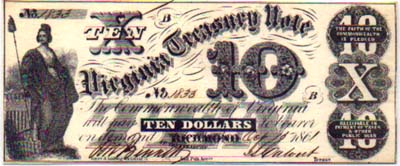
www.rebelstatescurrency.com
